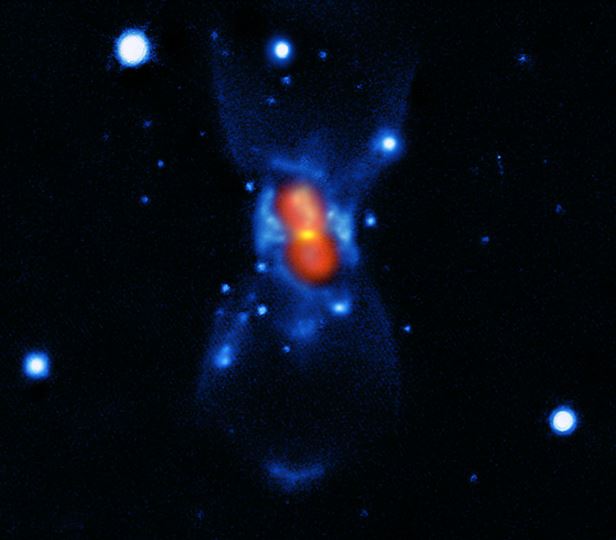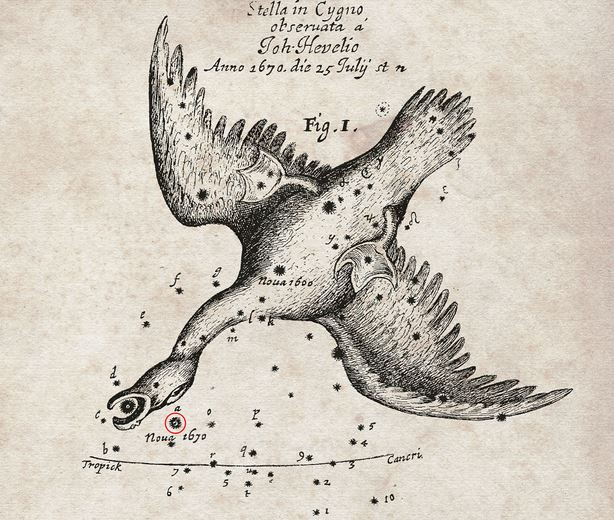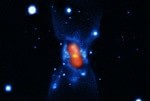In 1670, European astronomers saw a spectacular explosion in the sky, which the European Southern Observatory says was not a nova, but a much rarer, violent kind of stellar collision (two stars crashing into each other), following new observations with APEX and other telescopes.
The explosion 345 years ago was visible with the naked eye during its initial outburst. However, it left such faint traces that it was not until more than three centuries later using submillimetre telescopes, that scientists could finally determine was caused it.
The findings have been published in the academic journal Nature (citation below).

The remnant of the nova of 1670 seen with modern instruments. (Credit: ESO/T. Kaminski)
A number of seventeen century astronomers, including the father of lunar cartography, Hevelius, and Cassini, carefully documented the appearance of a new star in the sky in 1670.
Hevelius documented it as a nova sub capite Cygni (a new star under the head of the Swan). Astronomers know it by the name Nova Vulpeculaer 1670.
In astronomy, a nova is a star whose brightness suddenly increases significantly (because it exploded), and then slowly returns to its original state over a few months.
Modern astronomers are extremely interested in historical accounts of novae – they are not common. Nova Vulpeculaer 1670 is believed to be the oldest recorded nova and the faintest nova when later recovered.
Nova Vulpeculaer 1670 looked less and less like a nova
Lead author, Tomasz Kaminski, who works at ESO (European Southern Observatory) and the Max Planck Institute for radio Astronomy in Bonn, Germany, explains:
“For many years this object was thought to be a nova, but the more it was studied the less it looked like an ordinary nova – or indeed any other kind of exploding star.”
Nova Vul 1670 was clearly visible with the naked eye when it first appeared, and varied in brightness during the two years that followed. It then disappeared and reappeared two times before vanishing completely.
Although it was well documented, given when it occurred, the pioneering astronomers did not have the required equipment or technology to solve the mystery of the apparent nova’s performance.

The nova of 1670 recorded by Hevelius. (Image: ESO)
Nova Vul 1670 remained a mystery for a long time
Astronomers came to understand in the 20th century that most novae could be explained by the runaway explosive behaviour of close binary stars (two-star systems). However, Nova Vul 1670 did not fit this model well and remained an enigma.
Up until the 1980s, astronomers believed the apparent nova had left no trace. Then a team of scientists detected a very faint nebula surrounding where they believed what was left of the star was located.
While these observations were exciting because they were linked to the sighting more than three centuries ago, they still offered no insight into what caused the explosion.
Mr. Kaminski said:
“We have now probed the area with submillimetre and radio wavelengths. We have found that the surroundings of the remnant are bathed in a cool gas rich in molecules, with a very unusual chemical composition.”
As well as APEX (Atacama Pathfinder Experiment telescope), the scientists also used the Effelsberg radio telescope and the Submillimeter Array (SMA) to discover the chemical make up and measure the ratios of different isotopes in the gas. “Together, this created an extremely detailed account of the makeup of the area, which allowed an evaluation of where this material might have come from,” they wrote.
They found that the mass of the material was too great to be the product of a nova explosion. They also discovered that the isotope ratios they had measured around Nova Vul 1670 were not what one would expect from a nova. So, if it wasn’t a nova, what was it?
A spectacular stellar collision
It was a spectacular collision between two stars, much more brilliant than a nova, but not as bright as a supernova, which produces a red transient.
These are extremely rare events in which stars crash into each other, explode, spew material from their insides into space, eventually leaving behind only a faint remnant embedded in a cool environment, rich in dust and molecules.
This class of eruptive stars, which has only recently been recognized, fits the profile of Nova Vul 1670 almost perfectly.
Co-author Karl Menten concluded:
“This kind of discovery is the most fun: something that is completely unexpected!”
Citation: “Nuclear ashes and outflow in the oldest known eruptive star Nova Vul 1670,” Tomasz Kaminski, Karl M. Menten, Romuald Tylenda, Marcin Hajduk, Nimesh A. Patel and Alexander Kraus. Nature. Published online March 23, 2015. DOI: 10.1038/nature14257.
Video – Zooming in on Nova Vul 1670

